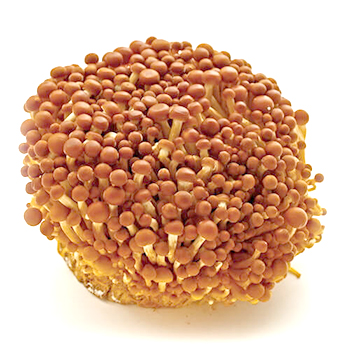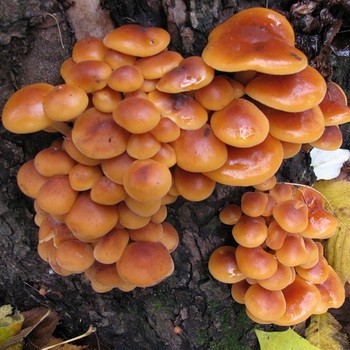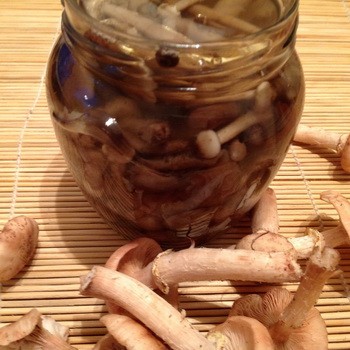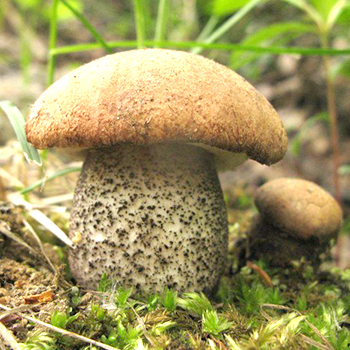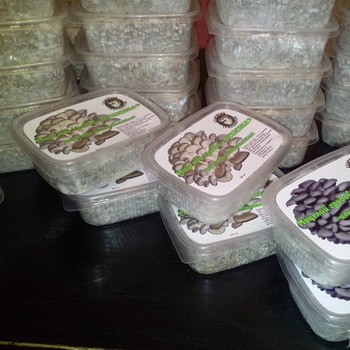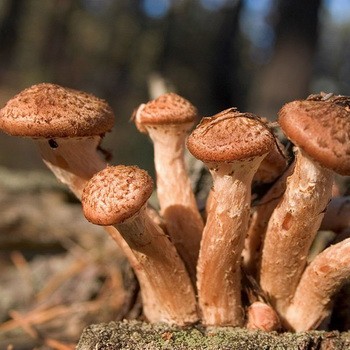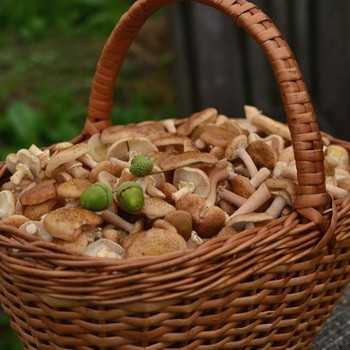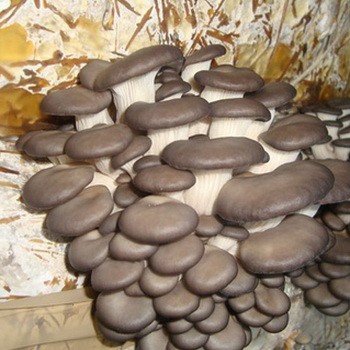Methods for growing summer and winter mushrooms
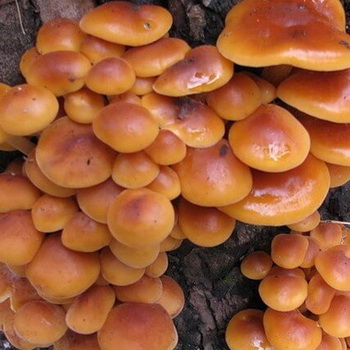
Among edible and suitable for cultivation, two species are distinguished: summer and winter.
You will learn about the basic methods of how to grow mushrooms mushrooms at home and in the infield by reading this article.
Content
What summer mushrooms look like
This mushroom is quite widespread, and mushroom pickers pick it in almost all forests. Little honey agarics grow on dead wood, as a rule, in numerous groups. Walking through the forest, one can often see a yellowish-golden hat formed by many individual mushrooms on fallen deciduous trees or stumps. This picture is observed from June to the month of September.
It is a small mushroom in size, the diameter of the cap usually varies between 20-60 mm, the shape is flat-convex, the edges are lowered. In the center of the cap there is a characteristic tubercle. The surface color of the honey foil is yellow-brown with specific watery lighter circles. The pulp is quite thin, delicate, white. Leg length - 35-50 mm, thickness - 4 mm. The leg is equipped with a ring of the same color as the hat, which can quickly disappear, although a clear trace will still remain.
Careful attention should be paid to the plates, which are first creamy in the edible honey agaric, and brown during ripening, which distinguishes them from poisonous false honeycombs. The plates of the latter are first gray-yellow, and then dark, greenish or olive-brown.
These photos show how summer mushrooms look like:
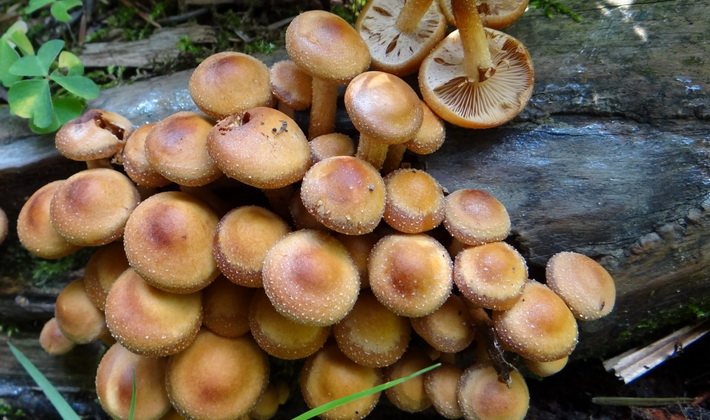
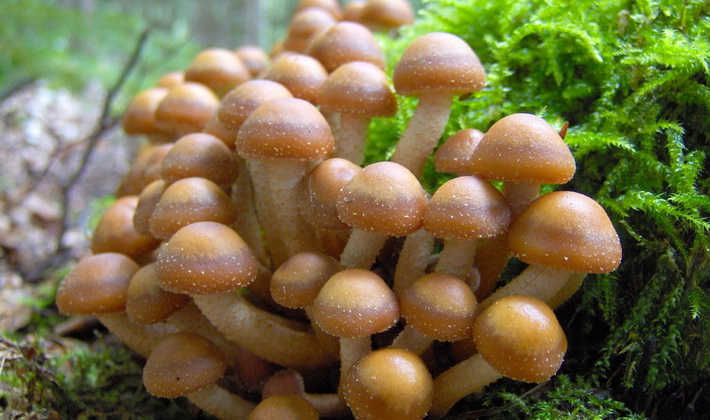
The taste of the mushroom is very high. The smell is strong and pleasant. Hats can be stored after drying.
Legs, as a rule, do not go to food because of their rigidity. On an industrial scale, honey wraps are not bred, because the perishable mushroom, which requires quick processing, besides, it can not be transported. But lone mushroom growers appreciate the mushrooms in Russia, the Czech Republic, Slovakia, Germany, etc. and willingly cultivate it.
The following describes how mushrooms can be grown in a garden.
How can I grow summer mushrooms on a stump
Dead wood is used as a substrate for growing summer honey mushrooms, and mycelium is usually acquired in the form of a paste in tubes. Although you can use your own planting material - a tincture of mature hats, a wad of wood or pieces of wood infected with a fungus.
Before growing mushrooms in the country, you need to cook mycelium. The infusion is made of hats with dark brown plates that need to be crushed and placed in a container of water (it is recommended to use rain) for 12-24 hours. Then the resulting mixture is filtered through cheesecloth and abundantly moisten the wood with it, having previously made cutouts at the ends and sides.
In addition to the infusion on the wood, you can lay out the mature hats with the plates down, removing them in a day or two. With this method of growing honey agarics, the mycelium grows for a long time and the first crop can only be expected to be obtained at the end of the next season.
To make the process faster, you should use pieces of wood with sprouted mycelium, which can be sought in the forest, starting in June. Attention should be paid to stumps or fallen tree trunks. Pieces should be taken from zones of intensive growth of mycelium, i.e. from where the most white and creamy threads (hyphae) are, and also a characteristic strong mushroom aroma exudes.
Pieces of wood of different sizes infected with the fungus are inserted into the holes cut out on the prepared piece of wood. Then these places are covered with moss, bark, etc. So that when growing summer mushrooms, the mycelium reliably moved to the main wood, pieces can be nailed and covered with a film. Then the first mushrooms are formed already at the beginning of next summer.
Regardless of the method of infection, wood of any hardwood is suitable for growing mushrooms on stumps. The length of the segments is 300-350 mm, the diameter is also any. In this capacity, stumps of fruit trees can also appear, which do not need to be uprooted, since in 4-6 years they will fall apart, being completely destroyed by the fungus.
On freshly cut wood and stumps, infection can be performed without special preparation. If the wood was stored for some time and managed to dry, then the pieces are kept in water for 1-2 days, and the stumps are poured over it. Infection for growing mushrooms in the country can be done at any time throughout the growing season. An obstacle to this is only too hot dry weather. However, be that as it may, the optimal time for infection is spring or early autumn.
The most commonly used wood for infection with honey agarics in central Russia is a birch, in which a lot of moisture remains after felling, and a reliable shell in the form of birch bark protects the wood from drying out. In addition to birch, alder, aspen, poplar, etc. are also used, but summer honey agaric grows worse on softwood.
Before growing mushrooms, watch this video:
Pieces of infected wood are set upright in pre-dug pits with a distance of 500 mm between them. Part of the wood from under the ground should look approximately 150 mm.
In order to grow mushrooms on stumps correctly, the earth must be abundantly watered and sprinkled with a layer of sawdust in order to prevent the evaporation of moisture. For such areas, you need to choose shaded places under the trees or specially designed shelters.
Optimal results can be obtained by placing infected wood in the ground in greenhouses or greenhouses where it is possible to control the level of humidity. In such conditions, the formation of fruit bodies of honey mushrooms takes 7 months, although if the weather is unfavorable, they can develop in the second year.
If you grew mushrooms in the country in the way that the correct technology suggests, the mushrooms will bear fruit twice a year (in early summer and autumn) for 5-7 years (if pieces of wood with a diameter of 200-300 mm were used, if the diameter is larger, fruiting may continue longer).
The yield of the fungus is determined by the quality of the wood, weather conditions, the degree of growth of the mycelium. Crop volumes can vary greatly. So, from one segment you can get both 300 g per year, and 6 kg per summer. As a rule, the first fruiting is not too rich, but the following fees are 3-4 times more.
It is possible to grow summer mushrooms on the site on forestry waste (small trunks, branches, etc.), from which bunches with a diameter of 100-250 mm are formed, infect with mycelium using any of the described methods and buried in the ground to a depth of 200-250 mm, laying on top of turf. The working area is protected from wind and sun.
Since honey agarics does not belong to mycorrhizal fungi and grows only on dead wood, its cultivation can be done safely without harm to living trees.
Details about growing mushrooms are described in this video:
Honey agaric is as tasty a mushroom as it is undeservedly ignored by mushroom growers. The cultivation technology described in general terms should be refined in each particular case, so amateur mushroom growers have great opportunities to show creative abilities in experimenting.
The following describes technology for growing mushrooms at home for beginners.
The technology of growing winter mushrooms at home
The hat of the winter honey agaric (velvet-legged flammulina) is flat, covered with mucus, small in size - only 20-50 mm in diameter, sometimes grows to 100 mm. The color of the hat is yellowish or cream, in the center it can be brownish. The cream-colored plates are wide and few in number. The flesh is yellowish. The leg 50-80 mm long and 5-8 mm thick is strong, springy, light above with yellowish, and brown from below, possibly black-brown (this feature makes it easy to distinguish this type of foment from others). The base of the leg is hairy and velvety.
Winter mushroom in vivo is widespread in Europe, Asia, North America, Australia and Africa. This tree-destroying mushroom grows in large groups, mainly on stumps and fallen trunks of deciduous trees or on weakened living trees (usually on aspen, poplar, willow). In central Russia, it is most likely to be found in September - November, and in the southern regions even in December.
Artificial cultivation of this variety of mushrooms began in Japan several centuries ago and was called "endokitake." However, both the quality and the yield during the cultivation of winter mushrooms on wooden chocks were very low. In the mid-50s. Japan patented the eponymous cultivation method on woodworking waste, after which cultivation of flammulins became more and more popular. At present, winter wrap on the volume of production is in third place in the world. Above is only champignon (1st place) and oyster mushroom (2nd place).
The winter honey agaric has undeniable advantages (winter harvest in the absence of wild competitors in the markets, ease of manufacture and low cost of substrate, short growing cycle (2.5 months), resistance to disease). But there are also disadvantages (high sensitivity to climatic conditions, in particular to temperature and the presence of fresh air, a limited selection of cultivation methods and techniques, the need for sterile conditions). And all this must be taken into account before growing mushrooms.
Although honey agarics takes the third place in industrial production, but among amateur mushroom growers, however, like mushroom pickers, it is relatively little known.
Since flammulin is related to mycorrhizal fungi, i.e. capable of parasitizing on living trees, it should be cultivated exclusively indoors.
The cultivation of winter mushrooms at home can be carried out both by the extensive method (i.e., using pieces of wood) and intensive (cultivation in a nutrient medium, the basis of which is sawdust of hardwood with various additives: straw, sunflower husk, beer pellet, corn, buckwheat husk , bran, cake). The type of additive used depends on the availability of appropriate waste in the household.
The proportions of the necessary ingredients for growing mushrooms at home can be different, taking into account the specifics of the nutrient medium. Sawdust with bran, which is a rich organic supplement, is mixed in a 3: 1 ratio, sawdust with beer grains is 5: 1, and the same ratio is used when mixing sunflower husks and buckwheat husks. Straw, corn, sunflower husk, buckwheat husks are mixed with sawdust in a 1: 1 ratio.
As practice shows, these are quite effective mixtures, which in the field showed good results. If you do not use additives, then yields on empty sawdust will be small, and the development of mycelium and fruiting will significantly slow down. In addition, straw, corn, sunflower husk, if desired, can be used as the main nutrient medium, where sawdust or other substrates are not needed.
It is recommended to add 1% gypsum and 1% superphosphate to the nutrient medium for growing home mushrooms. The moisture content of the resulting mixture should be 60-70%. Of course, you should not use ingredients if they are of dubious quality or with traces of mold.
After the substrate is ready, it is subjected to heat treatment. This can be sterilization, steaming or boiling water, pasteurization, etc. To grow mushrooms mushrooms, sterilization is performed by placing the nutrient medium in plastic bags or glass jars with a capacity of 0.5-3 liters.
The heat treatment process for cans is similar to ordinary home canning. Sometimes heat treatment is carried out before laying the substrate in jars, but in this case the containers themselves must also be thermally treated, then the protection of the nutrient medium from mold is more reliable.
If the substrate is planned to be placed in boxes, then the heat treatment is carried out in advance. The compost placed in the boxes is lightly tamped.
If we talk about the key conditions for growing mushrooms (temperature, humidity, care), it is necessary to strictly adhere to certain rules, on which the success of the whole event will depend to a large extent.
Heat-treated containers with a nutrient medium are cooled to 24-25 ° C, after which the substrate is seeded with grain mycelium, the weight of which is 5-7% of the weight of the compost. In the center of the can or bag in advance (even before the heat treatment) holes are made through the entire thickness of the nutrient medium using a wooden or iron rod with a diameter of 15-20 mm. Then the mycelium will spread fairly quickly throughout the substrate. After making mushrooms, cans or bags are covered with paper.
To grow mushrooms, you need to create optimal conditions. The mycelium grows in the substrate at a temperature of 24-25 ° C and takes 15-20 days to do this (the decisive importance for this is the characteristics of the capacity, substrate and varieties of foil). At this stage, the fungus does not need light, but it is necessary to ensure that the nutrient medium does not dry out, i.e. humidity in the room should be approximately 90%. Containers with a substrate are covered with burlap or paper, which periodically moisturize (however, they should not be allowed to get abundantly wet).
When the mycelium grows in the substrate, the coating from the containers is removed and they are transferred to a lighted room with a temperature of 10-15 ° C, at which you can get the maximum yield. After 10-15 days from the moment the cans were moved to the lighted room (25-35 days from the moment of seeding of the mycelium), a bunch of thin legs with small hats begins to appear from the containers - these are the rudiments of the fruit bodies of the mushroom. As a rule, the crop is removed after another 10 days.
Bunches of honey mushrooms are carefully cut at the base of the legs, and the stub remaining in the substrate is removed from the nutrient medium, best of all, using wooden tweezers. Then the surface of the substrate does not prevent a little moisten from the spray. The next crop can be harvested in two weeks. Thus, the moment of introduction of the mycelium before the first harvest will take 40-45 days.
The intensity of the appearance of mushrooms and their quality depend on the composition of the nutrient medium, the technology of heat treatment, the type of capacity used and other growing conditions. For 2-3 waves of fruiting (60-65 days) with 1 kg of substrate, you can get 500 g of mushrooms. Under favorable conditions - 1.5 kg of mushrooms with a 3-liter jar. If you are not lucky at all, then 200 g of mushrooms are collected from a three-liter jar.
Watch a video about growing mushrooms at home to better understand the process technology:
